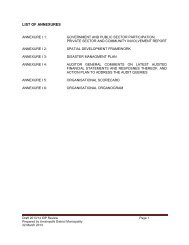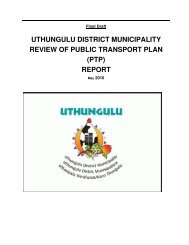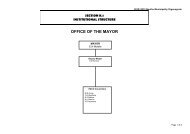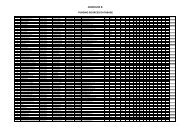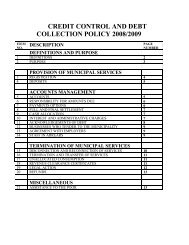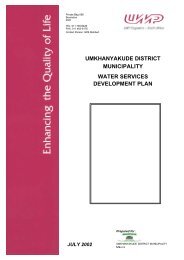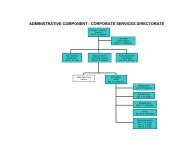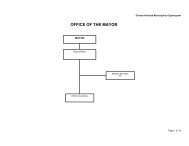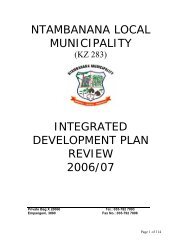Maphumulo IDP - KZN Development Planning
Maphumulo IDP - KZN Development Planning
Maphumulo IDP - KZN Development Planning
Create successful ePaper yourself
Turn your PDF publications into a flip-book with our unique Google optimized e-Paper software.
Settlement in <strong>Maphumulo</strong> Municipality occurs in the form of low density and sometimessprawlingsettlements reflecting the culture and tradition of the local communities. Thispattern is not sustainable and renders service delivery and development ineffective. Whilethis is critical in defining the structure and behaviour of settlements, it has given rise to acontinuum of rural settlement ranging from low density remotely located agrariancommunities to centrally located relatively high density settlements. Some settlementsdeveloped as a result of betterment schemes and land reform program. These have welldefined structure and pattern. A detailed consideration of the settlement pattern reveals ahigh level of interdependence and connectivity between settlements, and suggests thatthey are functionally integrated. They are spread in space in the form of footprints(unsystematic but logical). Higher density settlements are located along the maintransportation routes and are held together by a web of local access roads and publicfacilities located along these roads.At a regional level, they are knit together by a system of regional access routes. However,settlements are also not static. They respond to change and are continuously in the processof transformation.4.9 SPATIAL DEVELOPMENT STRATEGIESAlthough the current spatial pattern is inefficient and expensive, one has to admit that it is afixed spatial pattern. Therefore, the aim should not be to alter the existing spatial structure,but one should rather guide its future development towards a better, more efficient andmore cost-effective settlement structure. In short, one should start addressing the weaknessesof the spatial structure through the planning and development of its future growth. Fivestrategies can by adopted to achieve this:4.9.1 STRATEGY 1: RURAL INTEGRATIONSpatially the municipality aims to move away from the fragmented and sprawling ruralstructure existing within the majority of the wards. Consolidating all the existing outlyingsettlements with each around main access routes and service points should achieve this. Thiscan be done by filling in the unpopulated areas between these settlements with the futuregrowth of these settlements without compromising the subsistence land required for theserural settlements. By doing this, the settlements will join together and towards moresustainable nodal area, forming consolidated rural areas and in turn making service provisionmore financially viable. Such an integrated rural structure will form the bases for providingcost-effective municipal services and public transportation infrastructure. It should howeverbe noted that the position of the relatively sparse rural settlements will require long termcommitment to this spatial ideal.4.9.2 STRATEGY 2: BULK INFRASTRUCTURE DEVELOPMENTProviding bulk infrastructure can be an important tool to achieve the above-mentionedspatial pattern and will, in turn, result in cost savings when developing the bulk infrastructure.All future bulk infrastructures should be developed within the rural nodal areas describedabove; because where bulk infrastructure is developed, clustered development will follow. Inthis manner, bulk services will force future development into a more rational and desirablespatial pattern. At the same time, the location, implementation and functioning on the bulkservices network will be rationalised.__________________________________________________________________________________________<strong>Maphumulo</strong> Integrated <strong>Development</strong> Plan (<strong>IDP</strong>) 2012 - 2013Final June 2012Page 83 of 142



